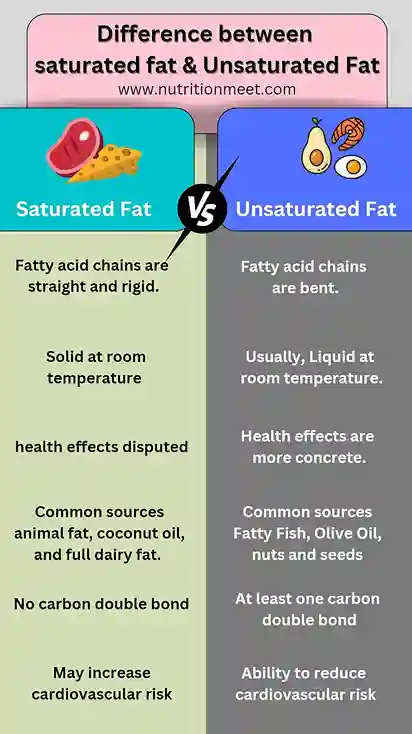When we hear “fat,” we immediately think about either body fat or dietary fat. what about Saturated vs Unsaturated Fat? Whatever it may be, either body fat or dietary fat, we always think about reducing it since we think body fat nurtures diseases and eating fat directly or indirectly leads to weight gain and thus increase body fat. Does that mean we should cut down fat from our diet?
No, because fat is required for the functioning of our body, an adequate amount of fat is necessary for the absorption of various fat-soluble vitamins like Vit A, D, E, and K. To lose or prevent excess body fat, you should consume the right amount of good fats a reducing intake of saturated fat; can prepare a diet plan for weight loss; identify the sources of good fat, etc. This article will help you understand the different types of fat, which are good and bad fat, which are good sources of fat, and how much fat you should consume to be fit and lose weight.

Table of Contents
What is dietary fat
Fats are the macronutrients that are absorbed by the body from food. Fatty acids, in general, contain straight alkyl chains with carboxylic groups. Its energy density is higher since fat provides around nine kcal/g while carbs and protein energy density are around 4 Kcal/g. Therefore, when you eat the same amount of food higher in fat get higher energy compared to the same food higher in protein or carbs [1].
Dietary recommendation for fat
For a newborn child or a child below six months, the major source of energy is fat; therefore, adequate intake (AI) is approx. 31g/d and AI for 7-12 months old infant is 30 g/day [7].
On the other hand, there is no established requirement for fat and dietary fat for adults. However, according to the WHO dietary reference intake recommendation, approx. 30% of total energy intake should be total fat; saturated fat should be restricted to 10% [2].
Types of fats
The fat can be categorized based on parameters like position and number of carbon-carbon double bonds, their chain length, and double bond trans and cis configuration. Following are the four main types of fat present in our diets.
Saturated fat
Saturated fatty acids (SFAs) are fats that have no double bond; instead, a variable number of carbon atoms forms a chain with a single bond, meaning they have a more significant number of hydrogen atoms. The saturation with hydrogen defines the name “saturated fat.”
Depending upon the no. of carbon atoms, they are categorized as short- and medium-chain saturated fatty acids (4 to 12 carbon atoms). Mainly found in milk fat, palm oil, coconut oil, beef, poultry, pork, bacon, hot dogs, chips, pastries, and so on [3].
Unsaturated fat
Unsaturated fatty acids and variable no of carbon atoms also have one or more carbon-carbon double bonds. A molecule with one double bond is called Monounsaturated fatty acid (MUFA), while a molecule with more than one double bond is called Polyunsaturated fatty acid (PUFA). They are generally in a liquid state at room temperature.
Examples of MUFAs are oleic acid and palmitoleic acid found in Olive oil, canola oil, peanut oil, and sesame oil. On the other hand, examples of PUFAs are linoleic acid, arachidonic acid (20 carbons, four double bonds), Omega-6-fatty acids, and omega-3 fatty acids found in fish and marine products, nuts, chia seeds, flax seeds, and so on [4].

Trans Fats
Trans fats are the geometric isomers (same atoms & bonding but different spatial arrangement) of unsaturated fatty acids. Mainly trans fats occur naturally in the fats of ruminants (2 to 7% beef fat and butterfat), whereas hydrogenation (addition of 2 hydrogen atoms to double bond carbon) causes the conversion of unsaturated vegetable oil fat to trans-fat [3].
Good Fats and their benefits
Switching to MUFA and PUFA from saturated fat can improve digestion, decrease oxidative stress, improve triglyceride levels, and protect the brain.
Monounsaturated fats enriched foods essentially play a role in the reduction of cardiovascular diseases, managing body weight, and other benefits. According to the studies, Olive oil source of MUFA (11 g/100g) used in the Mediterranean diet could reduce central obesity and the incidence of type 2 diabetes and cardiovascular disease. The anti-inflammatory activity of Palmitoleic acid was shown to induce an insulin-sensitizing effect [5].
Cis-PUFA includes important fatty acids, which are important versatile mediators for improving and maintaining the healthy life of human beings. Omega3 polyunsaturated fatty acids can regulate lipid metabolism, supports the central nervous system functioning & eyesight, and have essential properties like anticoagulant and antihypertensive [6].
Why avoid saturated fats
Although science has no clear clue with respect to the effects of saturated fat on health and is now not criticized for being unhealthy for cardiovascular functioning like they once thought, doctors may still suggest limiting saturated fat.
Saturated fat can elevate plasma cholesterol levels by elevating LDL levels which are correlated to the risk of cardiovascular disease; however, there is no clear association of causation [8].
Nonetheless, according to US Food, the food products naturally harboring saturated fat should be viewed as a part of the food matrix since cheese and yogurt not only contain saturated fat but protein, calcium, phosphorus, and vitamins A, D, and B12 which are essential for human health. Another reason is these nutrients naturally interact and can have a great influence on the absorption of others. For instance, Vit A and D require fat for absorption [9].
Conclusion
Fat is essential for the prevention of diseases, weight loss (With respect to keto and other fat diets), and the absorption of fat-soluble vitamins. There has been a trend to praise MUFA and PUFA for their benefits for the human body and constantly criticize Saturated fat for being bad for heart health, but research has proven there is no evidence for it. Therefore, it’s advisable to include a diverse source of fat like avocado, coconut oil, nuts, and seeds.
FAQ
Effect of unsaturated fat on the body?
Unsaturated fats are considered good fat since they can improve blood cholesterol levels, stabilize heart rhythms, and play other beneficial roles.
Source of fats?
You must include healthy sources of fats that are vegetable oils like olive oil, canola, sunflower, soy, corn, nuts, seeds, and fish.
What are fats in nutrition?
Fats are triglycerides with long chains of carbon with or without double bonds based on which they are structurally and functionally differentiated from each other. They are a source of essential fatty acids and are the only source of absorption of fat-soluble vitamins like A, D, and E.
Types of saturated fat?
Stearic acid, palmitic acid, myristic acid, and lauric acid are some of the know representatives of saturated fat.





